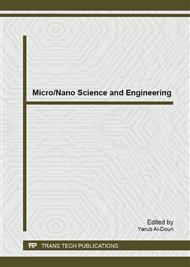[1]
Likharev K K, 2003, Nano and Giga Challenges in Microelectronics ed J Greer, A Korkin and J Labanowski (Amsterdam: Elsevier).
DOI: 10.1016/b978-044451494-3/50000-7
Google Scholar
[2]
Fischbein M D and Drndic M 2007 Sub-10 nm device fabrication in a transmission electron microscope. Nano Lett. 7 1329–37.
DOI: 10.1021/nl0703626
Google Scholar
[3]
Venkataraman L, Klare J E, Nuckolls C, Hybertsen M S and SteigerwaldM L 2006 Dependence of single-molecule junction conductance on molecular conformation Nature 442 904–7.
DOI: 10.1038/nature05037
Google Scholar
[4]
Haag R, Rampi M A, Holmlin R E and White H S 1999 Electrical breakdown of aliphatic and aromatic self-assembled monolayers used as nanometer-thick organic dielectrics J. Am. Chem. Soc. 121 7895–906.
DOI: 10.1021/ja990230h
Google Scholar
[5]
Q. Humayun and U. Hashim, Recent advancement in microgap electrode fabrication by conventional photolithography technique, 2012, pp.22-25.
DOI: 10.1109/smelec.2012.6417082
Google Scholar
[6]
Long D P, Patterson C H, Moore M H, Seferos D S, Bazan G C and Kushmerick J G 2005 Magnetic directed assembly of molecular junctions Appl. Phys. Lett. 86 153105.
DOI: 10.1063/1.1899772
Google Scholar
[7]
Ramachandran G K et al 2003 Electron transport properties of a carotene molecule in a metal–(single molecule)–metal junction J. Phys. Chem. B 107 6162–9.
DOI: 10.1021/jp0343786
Google Scholar
[8]
Galperin M, Ratner M A and Nitzan A 2007 Molecular transport junctions: vibrational effects J. Phys.: Condens. Matter 19 103201.
DOI: 10.1088/0953-8984/19/10/103201
Google Scholar
[9]
Datta S, Tian W, Hong S, Reifenberger R, Henderson J I and KubiakP 1997 Current–voltage characteristics of self-assembled monolayers by scanning tunneling microscoy Phys. Rev. Lett.
DOI: 10.1103/physrevlett.79.2530
Google Scholar
[10]
Q. Humayun and U. Hashim, Microstructure pattern etching by reactive ion etching (RIE) for future reproductivity of nanogap biosensor, 2012, pp.499-502.
DOI: 10.1109/iecbes.2012.6498101
Google Scholar
[11]
Bonnell D A (ed) 1993 Scanning Tunneling Microscopy and Spectroscopy: Theory, Techniques, and Applications (New York: VCH).
Google Scholar
[12]
Chen F, Qing Q, RenL, Wu Z and Liu Z 2005 Electro chemical approach for fabricating nanogap electrodes with well controllable separation Appl. Phys. Lett. 86 123105.
DOI: 10.1063/1.1871361
Google Scholar
[13]
Negishi R, Hasegawa T, Terabe K, Aono M, EbiharaT, Tanaka H and Ogawa T 2006 Fabrication of nanoscalegapsusing a combination of self-assembled molecular and electron beam lithographic techniques Appl. Phys. Lett. 88 223111–3.
DOI: 10.1063/1.2209208
Google Scholar
[14]
Venkataraman L, Klare J E, Nuckolls C, Hybertsen M S and Steigerwald M L 2006 Dependence of single-molecule junction conductance on molecular conformation Nature 442 904–7.
DOI: 10.1038/nature05037
Google Scholar
[15]
Haag R, Rampi M A, Holmlin R E and White H S 1999 Electrical breakdown of aliphatic and aromatic self-assembled monolayers used as nanometer-thick organic dielectrics J. Am. Chem. Soc. 121 7895–906.
DOI: 10.1021/ja990230h
Google Scholar
[16]
Q. Humayun and U. Hashim, Development of microstructure on polysilicon substrate by reactive ion etching (RIE) for future reproductivity of nanogap, pp.774-777, (2012).
DOI: 10.1109/smelec.2012.6417258
Google Scholar
[17]
Q. Humayun and U. Hashim, Effect of pH on the capacitive behavior of microgap sensor, 2012, pp.383-386.
Google Scholar


